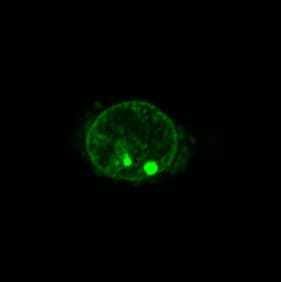Nucleolar Luminophore Ag-1 Small Molecule (Tool Compound)
Invented by Dr Michael (Mike) Coogan from Lancaster University
Invented at Lancaster University
- Datasheet
- References (2)
- Inventor Info
Info
| Catalogue Number | 152786 |
| Type | Luminophore |
| Relevance | Ag-1 is a luminescent trimeric, rehenium-based molecular vessel which strongly binds silver ions. Ag-1 displays a large Stokes shift (ca. 200nm) which compares very favourably with large Stokes shift materials such as quantum dots. A distinct pattern of localisation has been observed within the nucleus suggesting nucleolar localisation. This could be useful not only for the ability to image nucleoli, but also suggests applications in radiotherapy as Auger electrons emitted by certain isotopes are often considered to be most effective at killing tumour cells when in close proximity to nucleic acids. |
| Molecular Formula |
(ReO3N3C |
| Molecular Weight (g/mol) | 1735 |
| Solubility | DMSO |
| Research Area | Cancer |
| Notes |
Ag-1: λ max excitation = 371 nm (broad peak extends into the visible and can be excited at 405 nm in microscopy) λ max emission = 571; lifetime τ = 21 ns. Ag-1 does not release Ag+ except under forcing conditions, unlike physiological conditions. |
References: 2 entries
Thorp-Greenwood et al. 2011. Chem Commun (Camb). 47(11):3096-8. PMID: 21311811.
A 'Sleeping Trojan Horse' which transports metal ions into cells, localises in nucleoli, and has potential for bimodal fluorescence/PET imaging.
Europe PMC ID: 21311811
Add a reference
References: 2 entries
Thorp-Greenwood et al. 2011. Chem Commun (Camb). 47(11):3096-8. PMID: 21311811.
A 'Sleeping Trojan Horse' which transports metal ions into cells, localises in nucleoli, and has potential for bimodal fluorescence/PET imaging.
Add a reference












